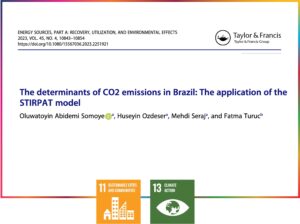
A study, co-authored by researchers Somoye, Özdeşer and Seraj from Near East University, sheds light on the intricate relationship between urbanization, economic growth, energy intensity, and carbon dioxide emissions (CO2) in Brazil. Utilizing innovative econometric techniques such as Non-linear Autoregressive Distributed Lag (NARDL) and Dynamic Ordinary Least Square (DOLS), the research explores the asymmetric effects of these factors on CO2 emissions from 1980 to 2022.
The findings of the study reveal intriguing insights into the dynamics of CO2 emissions in Brazil. Long-term analysis indicates that while urbanization and economic growth have varying effects on CO2 emissions, energy intensity consistently influences CO2 emissions positively. In the short term, adverse changes in urbanization and positive changes in energy intensity lead to an increase in CO2 emissions.
Policy implications derived from the research underscore the importance of targeted interventions to mitigate CO2 emissions. For urbanization, sustainable urban planning and rural development initiatives are recommended to promote green infrastructure adoption and ensure access to essential services. Policies aimed at promoting energy efficiency and clean energy sources can help counteract the small positive effect of economic growth on CO2 emissions. Additionally, investments in clean energy technologies and the implementation of carbon pricing mechanisms are suggested to further reduce CO2 emissions.
Despite its contributions, the study acknowledges limitations and suggests avenues for future research. Expanding the scope beyond Brazil and incorporating variables such as economic policy uncertainty and technological innovation can enhance the robustness of policy recommendations. Furthermore, exploring alternative econometric methods can provide deeper insights into the complex relationship between economic growth, urbanization, and CO2 emissions.
This collaborative research effort offers valuable insights into effective strategies for mitigating CO2 emissions in Brazil. By identifying the asymmetric effects of urbanization, economic growth, and energy intensity, the study provides policymakers with actionable recommendations to address environmental challenges and promote sustainable development.
More Information:
https://www.tandfonline.com/doi/full/10.1080/15567036.2023.2251921